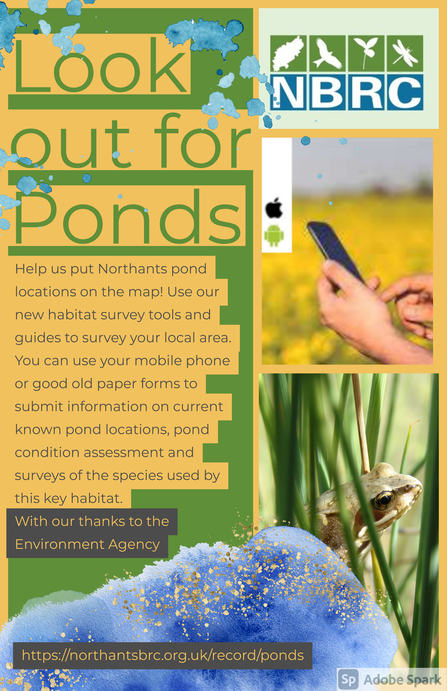Dotted through parks, naturally occurring in fields, or created as cherished homes for nature in our gardens; ponds act like stepping stones for a wide array of species. Be it, as habitats themselves or simply visited as water sources – small and vast alike, all support life.
Understanding where these habitats are distributed throughout the county, and any supporting information on their current condition arms us with the tools to inform landscape scale approach for species conservation.
How you can help
Our new survey aims to put Northamptonshire’s ponds on the map. You can submit useful information upwards from a location record (much like a biological species record- with grid ref, who you are, when and an identifier for the pond *if known). Any further information you can provide as guided by our survey forms on the pond area, condition, inhabitants and visitors will give a deeper picture of our wet habitats. Check you can access legally and survey safely using our advisory risk assessment.
Northamptonshire Biodiversity Records Centre: Look out for Ponds!
The survey is available as a paper form and replicated as a mobile app. Submissions are welcome via either method, and you can use them together - you may find the paper form useful to prepare for information requested. The mobile form will generate a GPS location using your phone (as will be validated against the location information you provide) and allow photos, taken on site via your phone camera to be added to your survey. Most of the mobile survey form fields are set up as optional, so you can submit what you know, upwards from basic location information.
Starting in winter when ponds are at their fullest gives you the opportunity to provide an accurate maximum pond area at the easiest time of the year. In summer it is still possible, though you will need to look for vegetation change and physical signs of the maximum water level. The extent of the waterbody (and information or drying and filling of this dynamic habitat’s cycle) is particularly useful when looking at a joined up approach for landscape scale species conservation. This can be submitted as simply as drawing on a OS map, by creating and submitting a GPS unit track file (where safe to do so) or if particularly techy and used to QGIS you can request our QField project.
It’s a great opportunity watch, revisit, monitor and learn more about your local ponds and the life they support. In spring, watch out for frog and newt spawn and keep ponds clear of alien invasive species; in summer, get pond dipping and try fishing for submerged plants with a grapnel; in autumn, start planning and building any new ponds and year round out watch for visiting birds, mammals and insect life.
Our forms (paper and mobile) include species lists to cover the life you may find, so that confidently identified sightings can be included as a biological record, simply and easily as part of your survey. There are local guides to get you started on our pond survey page; for aquatic plants as produced by Josh Hellon of the Monitoring and Research team, for Aquatic Invertebrates by County Recorder Kevin Rowley and links for online resources you may find helpful to get you started.
Put skills learnt through Wildlife Trust BCN Training Workshops to good use in generating species records along with your habitat survey. Spotted something tricky to ID? Our useful resources lists reference material and kit available on loan from our library, see if our facebook recording community can help or try contacting our list of local expert recorders, recording groups and national bodies.
Fancy building a new pond?
It is estimated that half a million ponds have been lost in the UK over the last hundred years. Creating a new pond is one best ways of attracting wildlife to your garden and it can be as simple as a repurposed washing up bowl with pathways for species to get in and out.

